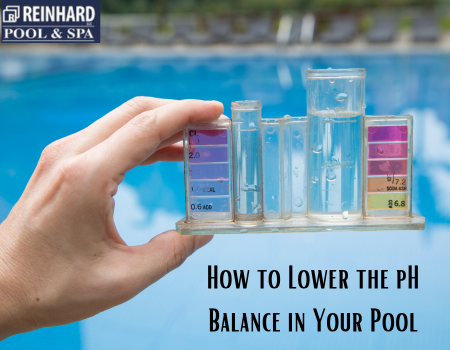Imagine diving into a refreshing pool on a hot summer day, only to experience stinging eyes and irritated skin. This discomfort might be a sign of imbalanced pool chemistry, specifically high pH levels. Maintaining a proper pH balance is crucial for a healthy and enjoyable swimming experience.
Understanding Your pH Balance and Its Importance in Pools
 pH is a measure of water’s acidity or alkalinity on a scale of 0 to 14. A pH of 7 is considered neutral, while values above 7 are alkaline and values below 7 are acidic. For a healthy pool, the ideal pH range is between 7.2 and 7.8.
pH is a measure of water’s acidity or alkalinity on a scale of 0 to 14. A pH of 7 is considered neutral, while values above 7 are alkaline and values below 7 are acidic. For a healthy pool, the ideal pH range is between 7.2 and 7.8.
Here’s why maintaining a proper pH level is important:
- Swimmer Comfort: High pH (water that’s too alkaline) can cause skin irritation, itchy eyes, and dry hair for swimmers.
- Equipment Protection: Imbalanced pH can damage pool equipment like filters, pumps, and liners. High pH can lead to scaling and corrosion.
- Sanitization Efficiency: Chlorine, the primary sanitizer in most pools, works most effectively within the ideal pH range. High pH reduces chlorine’s effectiveness, allowing algae and bacteria to grow.
Signs of High pH Balance in Your Pool
Several signs can indicate high pH balance in your pool:
- Cloudy water: High pH can make your pool water appear cloudy or hazy.
- Skin and eye irritation: Swimmers might experience itchy skin, red eyes, and a burning sensation.
- Scale formation: Calcium deposits and scaling on pool surfaces are a common sign of high pH.
- Less effective chlorine: You might notice a stronger chlorine odor, even with proper chlorine levels, indicating the chlorine isn’t functioning optimally.
Testing and Monitoring pH Levels
Regular testing is crucial for maintaining proper pool chemistry. Here’s how to test your pool’s pH level:
- Pool Test Kits: Liquid or strip test kits are readily available at pool supply stores. Follow the kit’s instructions to collect a water sample and test the pH level.
- Digital Testers: Digital pool testers offer a more precise and convenient way to measure pH levels.
Aim to test your pool’s pH at least once a week, and more frequently during hot weather or heavy pool use.
Lowering Your Pool’s pH Balance Safely and Effectively
If your pool test results show a pH level above 7.8, it’s time to take action to bring it down. Here are the two main methods for lowering pH levels:
- Adding pH Reducer: This is the most common and effective method. pH reducers are acidic chemicals specifically formulated for pool use. There are various types of pH reducers available, like dry acid (sodium bisulfate) and muriatic acid (hydrochloric acid).
- Dry Acid: A popular choice due to its ease of handling and storage. Always add dry acid slowly and wait at least 15 minutes between applications to avoid overshooting the ideal pH range.
- Muriatic Acid: A stronger acid that requires more caution in handling. Muriatic acid is typically used for large pools or situations requiring a significant pH balance adjustment. Wear proper safety gear like gloves, goggles, and protective clothing when handling muriatic acid.
- Natural Alternatives: Some pool owners prefer natural alternatives for lowering pH. However, these methods are usually less potent and might require more frequent application. Examples include borates and carbonic acid. Consult a pool professional before using natural alternatives to ensure they are compatible with your pool’s chemistry.
Important Considerations When Lowering Your pH Balance
Here are some key points to remember when lowering your pool’s pH:
- Always add chemicals slowly: Test the pH level frequently after adding small amounts of the chosen product. It’s easier to add more acid than to correct excessively low pH.
- Maintain proper circulation: Run your pool pump for at least several hours after adding a pH reducer to ensure even distribution throughout the water.
- Retest and repeat (if necessary): Continue testing and adding small amounts of pH reducer until the desired pH level is reached.
- Safety first: Always wear gloves, eye protection, and appropriate clothing when handling pool chemicals. Read and follow the manufacturer’s instructions carefully for safe handling and storage.
Preventing Future pH Imbalances (continued):
- Balancing other pool chemicals: Maintaining proper levels of chlorine and alkalinity can help buffer pH fluctuations.
- Minimizing external factors: Factors like rain, heavy bather loads, and pool chemicals used can affect pH. Minimize these influences when possible and adjust pH accordingly.
- Professional pool service: Consider consulting a pool professional for regular maintenance and chemical balancing, especially if you find maintaining pH levels challenging.
Maintaining a proper pH balance is essential for a healthy and enjoyable swimming experience. When you understand the importance of pH, recognize the signs of imbalance, and follow safe practices for lowering pH levels, you can keep your pool sparkling and ensure a comfortable swim for everyone. Remember, consistency is key. Regularly testing your pool’s pH and making timely adjustments will go a long way in keeping your pool balanced and inviting all summer long.
